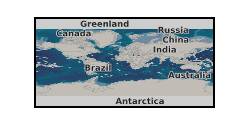Paleocene
Type of resources
Available actions
Topics
Keywords
Contact for the resource
Provided by
Years
Formats
Update frequencies
-
These files comprise lists of neogastropod species from the Early Cenozoic of Seymour Island, Antarctica and tropical counterparts in both the US Gulf Coast and Paris Basin. They comprise a key part of the raw data analysed in the paper Crame et al. (2018). For each of these three localities species are listed in taxonomic order, following conventional taxonomic notation. Faunas are listed for the Paleocene, Early Eocene and Middle Eocene time intervals for the two tropical localities, but only for the Paleocene and Middle Eocene of Antarctica. The accurate location of all the localities is given in a series of published papers. The Seymour Island samples were collected across three field seasons; 1999, 2006 and 2010. The US Gulf Coast and Paris Basin data were constructed from existing literature. Funding was provided by the NERC grants NE/I005803/1 and NE/C506399/1.
-

Cretaceous-Paleocene calcareous nannofossils from Site U1579 drilled on the Agulhas Plateau, Southwest Indian Ocean during International Ocean Discovery Program Expedition 392 Agulhas Plateau Cretaceous Climate in February-April 2022. The submitted files include data on Cretaceous-Paleogene (K-Pg) boundary calcareous nannofossil biostratigraphy and range chart, percentage assemblage counts and bulk carbon and oxygen isotopes from K-Pg sediment samples.
-

Geochemical and isotopic data presented here cover the Paleocene-Eocene Thermal Maximum (~56 Ma ago) and were produced to assess the degree of carbon cycle perturbations, ocean acidification and the origin of the emitted carbon added to the atmosphere-ocean system during this major carbon cycle perturbation event. For further details on the analytical approach please refer to the original publication (Gutjahr et al., 2017, Nature). Data contained within the two tables comprise foraminiferal carbonate based stable boron, carbon and oxygen isotopic results from DSDP Site 401 located within the Bay of Biscaye in the NE Atlantic (Table 1). This table also contains B/Ca, Mg/Ca and Al/Ca data from the same samples. Depth in core is presented alongside two alternative relative age models setting ages in relation to the Carbon Isotope Excursion observed during the Paleocene Eocene Thermal Maximum. Table 2 contains high-resolution bulk carbonate stable carbon and oxygen isotopic results that were produced to establish a new age models for this core.
-

The data include organic carbon and nitrogen abundances, carbon isotopes, nitrogen isotopes, major and trace element abundances, RockEval and mercury abundances from sedimentary strata across the Paleocene-Eocene thermal maximum. The samples include areas with hydrothermal influence linked to the emplacement of the North-Atlantic Igneous Province and others distal to hydrothermal activity to evaluate the effect of hydrothermal circulation on geochemical cycles. The results are linked to Rochelle-Bates et al. (in prep.) "Hydrothermal ammonium from a Large Igneous Province mitigated early Eocene climate change". * Note: U1568A Rockeval : Red filled cells highlight unreliable data with Tmax less than 350°C or greater than 450°C, or oxygen indices greater than 200.
-

The dataset consists of eleven spreadsheet tabs, each tab containing lipid biomarker palaeothermometry (air temperature reconstructions) and bulk organic carbon isotope data from individual lignites that are known to stratigraphically span the Cretaceous-Palaeogene (K-Pg) boundary. Uncalibrated, raw biomarker distributions (glycerol dialkyl glycerol tetraethers; GDGTs) are provided, as well as the calculated calibration outputs. Site coordinates are: West Bijou, Colorado (39°34'14'N, 104°18'09'W), Sussex, Wyoming (43°39'40"N, 106°19'06"W), Pyramid Butte, North Dakota (46°25'03'N, 103°58'33'W), Hell Creek Road, Montana (47°31'35"N, 106°56'23"W), Rock Creek West, Saskatchewan (49°02'20"N, 106°34'00"W), Wood Mountain Creek, Saskatchewan (49°25'20"N, 106°19'50"W), Frenchman Valley, Saskatchewan (49°20’56"N, 108°25’05"W), Knudesn’s Coulee, Alberta (51°54’27"N, 113°02’57"W) Griffith’s Farm, Alberta (51°54’47"N, 112°57’51"W), Coal Valley Cores (GSC CV-42-2, Cores 1 and 2), Alberta (53°05’02"N, 116°47’ 40"W) Police Island, Northwest Territories (64°52'42"N, 125°12'33"W).
 NERC Data Catalogue Service
NERC Data Catalogue Service